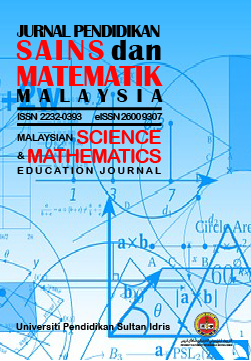Analysis of Misconceptions on Learning Geometry for Second-Grade Primary School Pupils
DOI:
https://doi.org/10.37134/jpsmm.vol12.1.2.2022Keywords:
Misconceptions, Second-Grade Pupils, Learning Geometry, Mathematics, Primary SchoolAbstract
The aim of this study is to identify the weaknesses of second- grade primary school pupils in learning Geometry topic. Based on the Mathematics Standard-Based Curriculum for Primary School, the Geometry topic consists of three content standards which are three- dimensional shapes, two-dimensional shapes and problem solving. Numerous studies have found that pupils have difficulties in learning geometry and lack of basic skills in mathematics. Thus, to fulfil this aim, a questionnaire was developed and administered to 30 pupils of Kerian District Primary School and supported by interview with three primary school teachers. The questionnaire data were analysed using the Statistical Package for Social Sciences and the results of the interviews will be analysed using ATLAS.ti. The results of this study revealed that the second-grade primary school pupils have several misconceptions especially on understanding the concept of three-dimensional shapes. It is believed that this study will help teachers develop and provide appropriate teaching and learning aids for pupils to improve their geometry understanding.
Downloads
References
Aktaş, M. C., & Aktaş, Y. D. (2012) Investigating high school students’ attitudes towards geometry according to different variables: Sample of ordu city. Dicle University Journal of Ziya Gökalp, 18, 156–167.
Berliner, D. C. (2014). Describing the behaviour and documenting the accomplishments of expert teachers. Bulletin of Science, Technology, and Society, 24(3), 200– 212. doi.org/10.1177/0270467604265535.
Berna, C. G. (2014). An investigation of pre-service elementary school teachers’ knowledge concerning quadrilaterals. Gukurova University Faculty of Education Journal, 43(2), 137–154.
Cohen, L., Manion, L., & Morrison K. (2017). Research Methods in Education (8th Ed.).
London: Routledge. doi.org/10.4324/9781315456539.
Creswell, J. W., & Plano Clark, V. L. (2011). Designing and Conducting Mixed Methods Research (2nd Ed.). CA: Sage.
Crompton, H., Grant, M. R., & Shraim, K. Y. H. (2018). Technologies to enhance and extend children’s understanding of geometry: A configurative thematic synthesis of the literature. Educational Technology & Society, 21 (1), 59–69.
Fattah, A., Yahya, T., Siraj, F. H., Kurniawan, S., & Mat Zain, H. (2021). Need analysis for development of pedagogical model integration of visualization technology to enhance performance in geometry. Jurnal Pendidikan Sains Dan Matematik Malaysia, 11(2), 110–121. doi.org/10.37134/jpsmm.vol11.2.9.2021.
Gay, L. R., Mills, G. E., & Airasian, P. W. (2012). Educational Research: Competencies for Analysis and Applications (10th Ed). Pearson.
Gunčaga, J., & Žilková, K. (2019). Visualization as a method for the development of the term rectangle for pupils in primary school. European Journal of Contemporary Education, 8(1), 52–68. doi.org/10.13187/ejced.2019.1.52.
Hiebert, J., Miller, E., & Berk, D. (2017). Relationships between mathematics teacher preparation and graduates’ analyses of classroom teaching. Elementary School Journal, 117(4), 687–707. doi.org/10.1086/691685.
Ibili, E., Çat, M., Resnyansky, D., Şahin, S., & Billinghurst, M. (2019). An assessment of geometry teaching supported with augmented reality teaching materials to enhance students’ 3D geometry thinking skills. International Journal of Mathematical Education in Science and Technology, 51(2), 224–246. doi.org/10.1080/0020739X.2019.1583382.
Ismail, H., Abdullah, A. H., Syuhada, N. & Noh, N. H. (2020). Investigating student’s learning difficulties in shape and space topic: A case study. International Journal of Psychosocial Rehabilitation, 24(5), 5315–5321. doi.org/10.37200/ijpr/v24i5/pr2020238337–351.
Jia Ling, T., & Matore, M. E. (2021). The use of information and communication technology in the teaching and learning of mathematics: A systematic literature Review. Jurnal Pendidikan Sains Dan Matematik Malaysia, 11(1), 45-59. doi.org/10.37134/jpsmm.vol11.1.5.2021.
Lee Abdullah, M., & Wei, L. (2017). Learning form one geometry: Validity and reliability of a self-evaluation instrument. Malaysian Journal of Learning and Instruction, 14(1), 211–265. doi.org/10.32890/mjli2017.14.1.9.
Luneta, K., & Makonye, P. J. (2010). Analysing grade 12 learner errors and the misconceptions in calculus. Acta Didactica Napocensia, 3(3), 35–46.
Mackle, K. (2016). Tackling Misconceptions in Primary Mathematics: Preventing, Identifying and Addressing Children’s Errors (1st ed.). London: Routledge. doi.org/10.4324/9781315695570.
Marchis, I. (2012). Pre-service primary school teachers’ elementary geometry knowledge. Acta Didactica Napocensia, 5(2), 33-40.
Ministry of Education Malaysia (2016). Primary School Standard Curriculum, Standard Document for Curriculum and Assessment: Year Two Mathematics. Kuala Lumpur: Curriculum Development Division.
Özerem, A. (2012). Misconceptions in geometry and suggested solutions for seventh grade students. Procedia - Social and Behavioral Sciences, 55, 720–729. doi.org/10.1016/j.sbspro.2012.09.557.
Prabowo, A., Anggoro, R. P., Astuti, D., & Fahmi, S. (2017). Interactive multimedia based teaching material for dimensional geometry. Journal of Physics: Conference Series, 943, 2. doi.org/10.1088/1742-6596/943/1/012047.
Serin, H. (2018). Perspectives on the teaching of geometry: Teaching and learning methods. Journal of Education and Training, 5(1), 1. doi.org/10.5296/jet.v5i1.12115.
Serin, H. (2018). A comparison of teacher-centered and student-centered approaches in educational settings. International Journal of Social Sciences & Educational Studies, 5(1), 164–167. /doi.org/10.23918/ijsses.v5i1p164.
Sujarwo, M., Kurniawan, S. B. (2020). Analysis on mathematics learning misconceptions of the second-grade students of elementary school in addition and subtraction integer topics. Advances in Social Science, Education and Humanities Research, 397, 757–764. doi.org/10.2991/assehr.k.200129.095.





